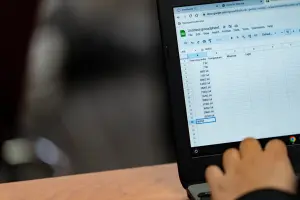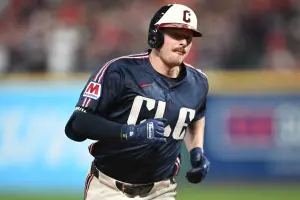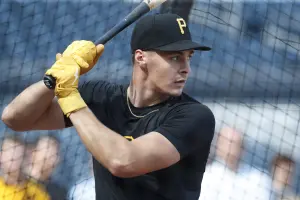
(*)ROTISSERIE: LABR Mixed 2020—Film review
You just can't beat an in-person draft, so I tried what I thought might be the next best thing: streaming Tuesday's LABR Mixed (online) draft live from the BaseballHQ YouTube account. The experiment was a blast—I lasted just over two hours (16 rounds) on camera with plenty of engagement from those following at home.
So we'll weave that concept into this recap column, combining my pre-draft process (that you can hopefully use in your own draft prep) and in-draft execution with some film review as we go.
And yes, some thoughts on the elephant in the room, sixth-round pick James Paxton, at the end.
- LABR draft results can be found here: https://rtsports.com/labr-mixed-draft
- And my live stream here: https://youtu.be/Uk-hFhy0d_Q
Mapping it out
Part 1: Rounds 1-4
Draft slots were assigned roughly one week ahead of the draft, which gave me plenty of time to (over)think how I'd tackle the 13-slot in this 15-team, 5x5 format. I like to map out a couple of scenarios for Rounds 1-4, grouping players by "type" (power, balanced, speed, pitcher, etc.) based on recent Average Draft Position (ADP) from the NFBC.

- The market is obsessed with "getting speed early" via five-category hitters. Every first-round hitter except Trea Turner is a "balanced" hitter (i.e. elite power, BA, and 10+ SB).
- There's a chance one of the three first-round pitchers (Gerrit Cole, Jacob deGrom, or Justin Verlander) will be available to me at 13, which piques my interest.
- Starting with my third-round pick, pitchers are slated to go in seven of the next 12 picks. There might not be many bats available to me in the third, which affects how I'll draft in Rounds 1, 2, and 4.
My take on the whole deal (volume check!) as the draft got underway:
So my final plan for the first four rounds centered around two options: take a Top 3 pitcher in the first round (Verlander, Cole, or deGrom), or wait and grab one at the 3-4 turn:
Option 1: Pitcher at the 1-2 turn Round Targets ===== ================ 1 SP: Cole/deGrom/Verlander 2 Best hitter: Freeman, JRamirez, Soto, Arenado, Bregman 3/4 Hitter: Blackmon, Baez, Springer 3/4 SP: Corbin, Kershaw, Castillo, Bauer, Darvish Option 2: Pitcher at the 3-4 turn Round Targets ===== ================ 1/2 Pick 2: Freeman, JRamirez, Soto, Arenado, Bregman, JDMartinez 3 Corbin, Blackmon, Baez, Springer 4 Kershaw, Castillo, Bauer, Darvish, Merrifield
Having a few contingencies in place can help ease you into the flow of the draft, as you can generally guess which types of players will be available to you in your first couple rounds.
Part 2: Rounds 5+
I take a more macro-level approach here, breaking down the rounds by buckets and counting the number targets I like in each bucket. For example, if I know that I like five shortstops in Rounds 16-20, I might opt for a similarly-skilled hitter at a different position earlier in the draft.
Counting "highlighted" players on my spreadsheet—I use my own twist on the Mayberry Method to rate players and compare those ratings to ADP—here's what I came up with:
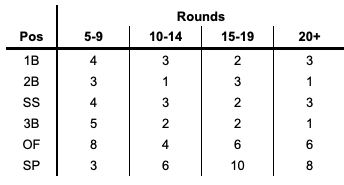
A few takeaways to help shape my general draft plan after Round 4:
- With a bunch of SP targets in the late rounds, I might wait to fill out the back of my rotation, focusing mostly on hitters and closers in Rounds 5-14.
- Second base is pretty rough this year. If I don't get a 2B in Rounds 5-9, I'm probably not getting one until later.
- With 10 outfielders I'd love in Rounds 10-20 (and 12 I'd be happy with after the 15th), I don't want to grab too many OF early in the draft and miss out on those late values.
Film review time for those last two bullet points, as I tried to avoid taking too many outfielders early, but had a decision to make once two second-basemen were picked before me. Let's roll the tape:
Film study: Playing the wheel
In traditional Baseball Forecaster form, my pros and cons of drafting at the wheel. CON: Missing out on an in-draft pitcher run; too much downtime in between picks (not a problem with a live stream!). PRO: Bullying the board with two picks at each turn; playing off adjacent team needs as they wrap around the turn.
An example of this in action, where I debated going catcher vs. closer at the 13/14 turn:
A thing of beauty (and I have to show something that worked, right?). If you have a draft slot choice and prefer drafting near the wheel, go for a slot one or two spots away from the first/last pick and use that to your advantage.
Film study: The snipe
No real analysis here, but we all know the feeling. Your guy is in the queue (or is that a bad luck charm?), you're ready to roll just one pick away, and then... boom. Enjoy as I mourn the loss of Hector Neris in the 11th round and pivot to my next move:
The Results
Here's the final damage (projected stats from January 31):
Hitter Rd R AVG HR RBI SB
=============== == === ==== == === ==
C Carson Kelly 13 53 .249 21 65 0
C Kurt Suzuki 24 38 .264 13 54 0
1B Freddie Freeman 1 100 .301 36 103 7
3B José Ramírez 2 93 .281 28 100 27
CI C.J. Cron 16 73 .258 36 95 1
2B Jonathan Schoop 19 76 .263 30 79 2
SS Corey Seager 9 74 .278 19 78 1
MI Jean Segura 11 77 .290 10 54 16
OF George Springer 3 99 .281 34 85 7
OF Ramón Laureano 5 84 .280 25 67 17
OF Nick Castellanos 7 84 .288 25 83 2
OF David Dahl 12 71 .282 21 65 7
OF Randal Grichuk 17 81 .249 34 88 4
UT Jon Berti 21 80 .249 12 45 29
RES Rowdy Tellez RES Jake Fraley RES Adam Frazier RES Domingo Santana Total 1083 .273 344 1061 120 Target 1100 .269 355 1070 120 Pitcher Rd W WHIP K ERA Sv =============== == == ==== === ==== == P Clayton Kershaw 4 14 1.07 189 3.21 0 IL James Paxton 6 15 1.22 209 3.67 0 (HA!) P Max Fried 10 13 1.34 179 3.93 0 P Joe Musgrove 15 11 1.24 157 4.29 0 P Griffin Canning 18 6 1.30 127 4.32 0 P Kyle Gibson 22 10 1.38 183 4.38 0 P Pablo López 23 7 1.32 132 4.44 0 RP Taylor Rogers 8 2 1.09 66 2.79 30 RP Ian Kennedy 14 3 1.33 59 3.72 32 RES Tyler Beede RES Michael Pineda
Total 81 1.26 1301 3.90 62 Target 85 1.22 1400 3.85 70
A few quick hits/larger takeaways as I left the table:
- Hitting seems balanced based on my projections vs. targets, though my SB contributions aren't distributed very well. If Ramirez (27 steals), Berti (29), Laureano (17), or Segura (16) go belly-up, I'll be hurting in bags. I'd much rather build my SB foundation with a bunch of 10-15 SB targets.
- I fell slightly behind in power early, but was able to recover by grabbing CJ Cron (Round 16), Randal Grichuk (17) and Jonathan Schoop (22). Power is everywhere, sure, but given that you needed 26 HR per player (including catchers) to finish in the 80th percentile of NFBC leagues last year, it's easy to fall behind.
- The pitching targets look strong enough. I liked the ratio/strikeout combination of Kershaw/Paxton at the top despite some volume concerns, while several mid-round targets (Fried, Musgrove) fell into place, and I left the draft with a pair of closers who have full-time gigs.
Overall, vibes were good when I went to bed Tuesday night, but then...
James Paxton and the "Health Hush"
Page 24 of the (award-winning!) Baseball Forecaster has a prescient little blurb on what we call the Health Hush:
Players get hurt and potentially have a lot to lose, so there is an incentive for them to hide injuries. HIPAA laws restrict the disclosure of health information. Team doctors and trainers have been instructed not to talk with the media. So, when it comes to information on a player’s health status, we’re all pretty much in the dark.
I don't want this to sound like sour grapes, so I'll start this off by saying there's nobody to blame for picking James Paxton but… me. I pulled the trigger knowing there were volume concerns and a lengthy list of IL stints over the years. That's on me.
So sure, I was bummed when I saw the news that Paxton had back surgery Wednesday morning and would be out 3-4 months. And then I saw this tweet from New York Post writer Joel Sherman:
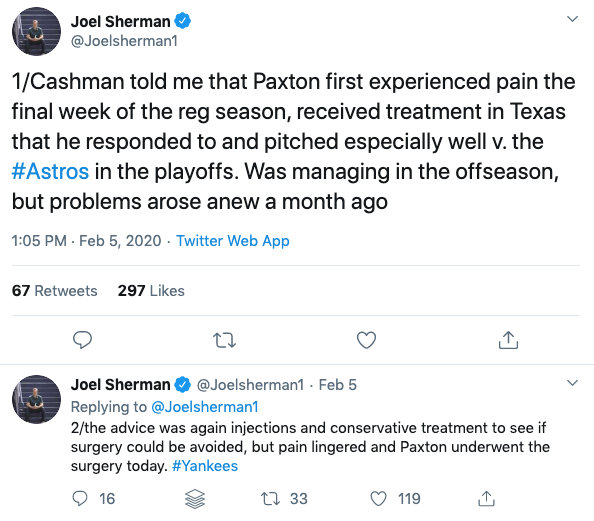
Little did I know when I took Paxton in the sixth round Tuesday night, he was off solid foods and only drinking clear liquids in prep for the following morning's surgery.
I don't blame Paxton or the Yankees for not disclosing this stuff—they don't have to—but just know that the information we pour through all spring is sometimes just a sliver of the truth. Your next draft pick might be quietly getting injections to ease pain, mulling the pros and cons of surgery, or hiding an injury from their team altogether.
And we'll have no idea. How's that for optimism!
Conclusion
If recent history is any indication, nearly half of these players will hit the IL at some point. It's a long season, so while the Paxton injury puts a dent in my staff, it far from buries me. Replacing his production by scouring the FAAB and trade markets becomes paramount. You just have to keep grinding.
As for the live stream, I'd be interested to see how many of you enjoy that type of format for future events (a la our Online First Pitch Forums, coming soon!). It sure was a fun time on my end; the multi-tasking wasn't as hard as I thought it might be.
And as for Paxton—get well soon, man. Back surgery is no joke. See you in June—just let me know if there's a setback next time, ok?



